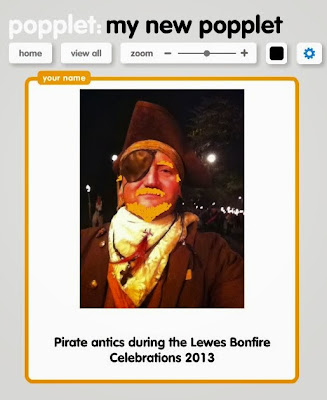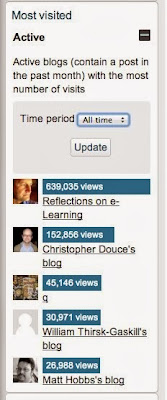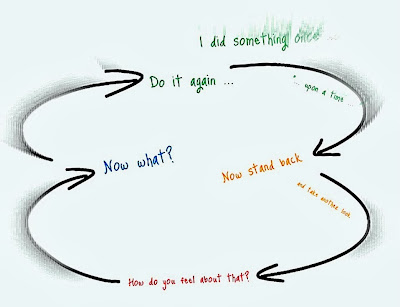If you are doing a Masters of Open and Distance Education Module (MAODE) you should be aware of an interested in the conference that is currently running in CloudWorks and OULive.

Access to the conference sessions is limited to H818 participants, MA ODE alumni, and IET staff.
If you fall into one of these categories and would like to register for the conference, please complete this short Registration Form.

Fig. 1. Lewes War Memorial, East Sussex, England  J F Vernon (2011)
J F Vernon (2011)
The problem with war memorials is that those named on them risk becoming forgotten words on a list.
By using the Web we can find out who these people named on the war memorials were and where they lived; we can try to put a face to the name and a story to the name … and then we can share what we find.
There are more than 54,000 war memorials in Great Britain, most of these put up after the First World War. There is barely a community without one. Significant interest already exists, especially as we approach the centenary of the First World War making this initiative a potentially easy one to add to what is already taking place.

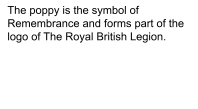
Fig. 2. British Legion Poppy featuring a Quick Response Code
In his 2011 book ‘The Digital Scholar’ Martin Weller shares the thoughts of Brian Lamb to describe those technologies that ‘lend themselves to … the networked and open approach’ as ‘fast, cheap and out of control’. It was with this in mind, taking an interest in the centenary of the First World War and obsession with war memorials that I started to think about using Quick Response codes as a personalised entry point to the Web that anyone could generate in order to share a story about someone who served in the conflict, and to do so both online and on the street. Quick Response codes are fast, they are free and their potential in learning has yet to be realised.
Worn in this way, featured in the center of your commemoration Poppy, you can share directly with others the person whose life you wish to remember, as well as directing people to the content online and inviting them to ‘adopt’ a name from a war memorial themselves. Though exploiting the Web, this is designed as a ‘blended’ experience that uses face-to-face, community and classroom experiences, as well as taking people outside to monuments, buildings, streets and battlefields.
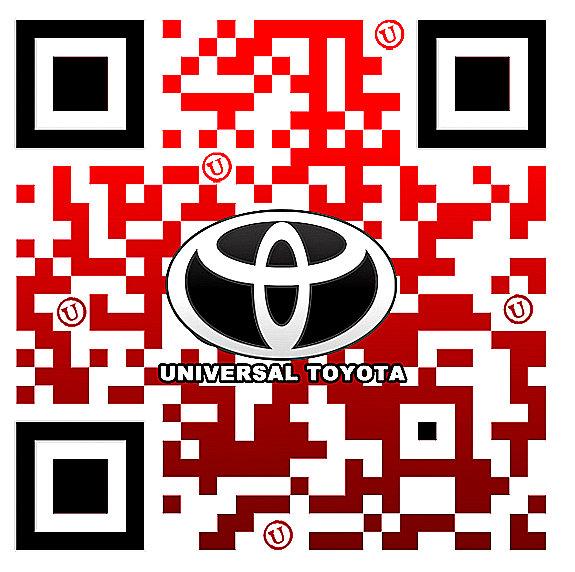

Esponsorvik (2014 )
Fig. 3. Toyota Quick Response Code and Using a TV remote control Espensorvik. Flickr
‘QR codes’ are a product of the car manufacturing industry. Faced with increasingly complex components, Denso, a supplier to Toyota, came up with what is a 2 dimensional bar code in the 1990s (Denso, 2010). Made free of patent, and using free software anyone can now generate their own unique QR code. You can even print them out on standardised sticky label stationery.

Fig. 4. Google Search ‘Quick Response Codes Education Images’ (2014)
There are a myriad of uses for QR codes, from embedding information that is read and stored by the device to a quick link to rich content online. Barrett, 2012). The interest here is to use QR codes to link to learning resources, in mobile, or ‘m-learning’ contexts in particular and for users to both read and write such context. I liken QR codes to using your phone as a remote control to click to a TV channel (Fig 3) . You point a smartphone, or tablet at the QR code to read it and go instantly, pretty much, to a web page.
Their use in education in the last decade has been limited. ‘Refereed (sic) papers are few’ (Gradel & Edson, 2012), but between these and other published reports, suggestions can be made regarding their strengths or weaknesses.
If QR codes are to be used successfully then champions need to be identified to take up the cause in schools, colleges and local associations. Whilst QR codes use the power of the Web to connect people to rich content, that they may create themselves, a good deal of thoughtful planning will be necessary ‘in the classroom’, not just explaining how to make use of QR codes, but also working them in, where appropriate to current learning schedules where QR codes used in this way will meet clear learning objectives. Support online could be provided in a short eLearning module. What has been shown repeatedly, in museums and ‘out in the field’, is that simply ‘put out there’ the QR codes are ignored (Gradel & Edson, 2012). An innovation such as this requires considerable promotion and support. This makes the idea of wearing your own QR code on a Commemoration Poppy all the more appealing, as each person becomes an ambassador on the ground, for that nugget of information, especially if they are responsible for creating and hosting that content. The opportunity exists, therefore, mentored and guided by educators, with support online, for schools, colleges and associations to engage people in bringing the stories of those named on our war memorials alive. In this way a deeper and more meaningful connection is made with the past and our relationship to it.

Copyright © 2010, The New York Times Company. Photography by Jim Wilson
Fig. 5. Handheld curator: IPod Touches and visitors at the San Francisco Museum of Modern Art. (The New York Times)
According to the 2009 Horizon report (Horizon, 2009) the following would be of growing significance in teaching: mobile devices, clouding computing and the personal web. As an innovative approach, QR codes exploit all three of these developments.
Use of QR codes in learning however has had mixed results. Simply putting a QR code in front of a museum artifact, as they’ve done at the Museum of London and did at the Design Museum does not work (Vernon, 2013) – there is plenty already, there is little to attract or promote their use, not everyone has a smartphone or tablet of course and the technology is often not robust – ‘out of use’ signs are familiar. Outdoors QR codes added to signs in the South Downs National Park, for example, barely received a view a day during a three month trial and in some instances there was no signal at all (Kerry-Bedel 2011; South Downs, 2012).
Where QR codes have been successful is in targeted learning experiences in schools (Tucker, 2011; Gradel & Edson, 2012), where the affordances of the QR code have been exploited to form part of an engaging, constructive and collective learning experience. To be effective this initiative with war memorials requires galvanising people to take part in a joint exercise – easier with a class in school or college, less easy with the general public unless it is through a national, regional or local community association or interest group.
Examples where QR codes work include where participants are ‘equipped’, and where they can take an active role, such as in ‘on the spot’ surveys or quizzes, where they are prompted into cooperative learning and where timely ‘Frequently Asked Questions’ are given. (Awano, 2007: Information Standards Committee 2008; So 2008; Robinson, 2010; Hicks & Sinkinson, 2011; Ryerson Library & Archives, 2012.)
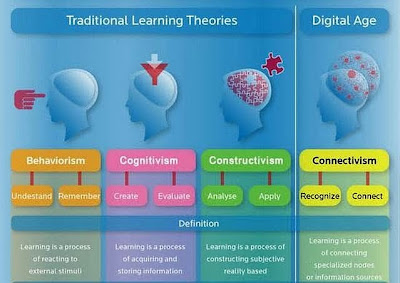
K Lepi (2012)Copyright 2013 © Edudemic All rights reserved
Fig 6 . A Simple Guide to Four Complex Learning Theories. Lepi (2012)
The theory behind the idea of using QR codes in a mobile and open way, is that in the digital age ‘connectivism’ is the ‘modus operandi’. In this diagram (Fig. 5) from Edudemic (Edudemic 2012) traditional and digital theories are concerned. All are relevant, each has its place, with the digital environment offering new and additional approaches to learning.
Whilst traditional learning methods have their role in schools, lecture halls and with mature students too, the complete learning package requires a level and quality of interaction and connectedness that can only be achieved on the Web and be effective where the body of learners is large and their approach is open and shared so that knowledge acquisition comes through the challenges and rewards of such intercourse. Connections won’t occur however unless they are nurtured. By way of example, wishing to support and promote the combat memoirs of my late grandfather John Arthur Wilson MM (Vernon, 2012) a number of organisations will be approached up and down the UK in relation to his experiences in the Durham Light Infantry, Machine Gun Corps and Royal Air Force. The Web will both help identify, forge and maintain and develop first and subsequent connections in what would hopefully be, to be effective, a two way, shared, open and reciprocal relationship. The beauty of having content already online is that others can quickly view it and images, text and sound files, even video, adjusted to suit different audiences, or uses - and used freely where appropriate copyright permissions are given.
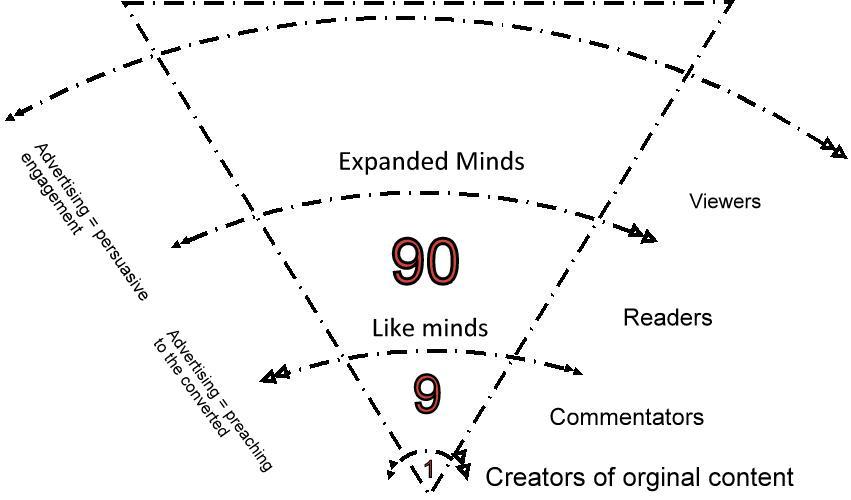
 JFVernon 2010 from statistics from Jakob Nielsen (1999)
JFVernon 2010 from statistics from Jakob Nielsen (1999)
Fig 7 . Creators, commentators and readers - how use of the Web stacks up. Vernon (2010) after Nielsen (1999)
This degree of connectedness does not come naturally. Just as there can be no expectation that people will use a QR code because it is there – they won’t. With an innovative approach such as this promotion is crucial. Significant time, thought and effort need to be put into letting people know what is taking place and supporting their participation.
Only a fraction of a population are naturally inclined to generate content.
Jakob Nielsen (1999) would suggest that as few as 1% create content (Fig. 6). If content is therefore to be created by participants then very large numbers need to be made aware of the initiative. Online, openness helps when it is massive. Participation is improved where it is supported and moderated. Creators, commentators and readers each have a role to play.
The balance needs to be found between the qualities of a tool that is fast and cheap and where out of control means that something isn’t used in a way to benefit a formal learning requirement. On the one hand those who want to generate content can be encouraged to do so, while in a formal setting the intention would that everyone generates content of some form in order to receive feedback and assessment.

J F Vernon (2011) 
Fig 8. The Newcastle War Memorial by Sir William Goscombe John RA
The potential weakness of using QR codes are the requirement for participants to have a suitable device, say a smartphone or tablet and the possible communication fees when connecting away from a free wi-fi source – which is likely to be the case at a war memorial (Gradel & Edson, 2012). Reading from and using a smartphone or tablet may also present accessibility issues, from the need for dexterity and reading content that isn’t offered in alternative forms, such as text sizes and background or audio alternatives.
There are many examples where local councils feel a war memorial or building is so important that they have invested in information placards on site (Fig. 7). As commemoration of those who served and died in the First World War is of local and national interest funding is potentially available to help support initiatives such as these through the Heritage Lottery Fund, while organisations such as the Western Front Association have funding for branch activities too.
If permission is required for personalisation of a British Legion poppy using a QR code, then alternatives may be required, from working with other suitable groups such as the Imperial War Museum or Western Front Association to putting the QR code on a badge instead. Where used in the field it is likely that a teacher would put out sets of QR coded markers in advance and collect them afterwards. Where a photograph in a town featuring before and after views permission may also be required if any kind of QR coded plaque or poster is to be put up. Other inventive ways to use a QR code would be to attach them to an obstacle course like trench experience where each code triggers elements of a task, sound effects or narrative in keeping with the setting. By way of example, at the ‘In Flanders Museum’ in Ypres a number of exhibits require the visitor to duck, crawl or crane their neck before supporting audio or lighting is triggered by a Near Field code in a bracelet.
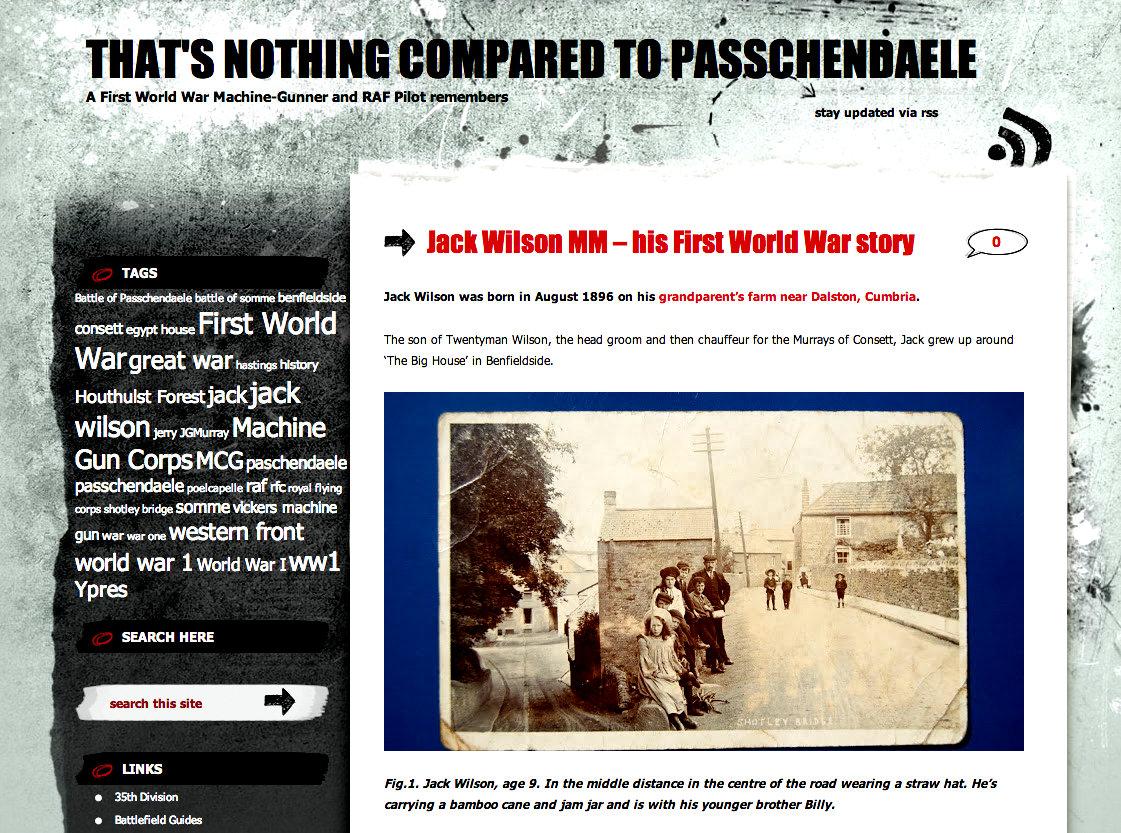
 J F Vernon (1989-2014)
J F Vernon (1989-2014)
Fig. 9. The memoir of a Machine Gunner and RFC Fighter Pilot. ‘That’s Nothing Compared to Passchendaele’
In his 2011 book ‘The Digital Scholar’ Martin Weller shares the ideas of Robert Capps (2009) who coined the term ‘the good enough revolution’ – in relation to creating and sharing content in an open culture. This precludes being prescriptive or from expecting perfection. Whilst output on the First World War from the BBC, the Imperial War Museum or the Open University should understandably attain a certain professional standard, the kind of creation required of those research names on war memorials should take inspiration from that is more than just ‘good enough, from ‘pinning’ names from a war memorial to a home address, to ‘pinning’ submitted World War One photographs to Google maps over former battlefields, as well as numerous inventive YouTube videos and memoirs presented as blogs.
REFERENCE
Awano, Y (2007). Brief pictorial description of new mobile technologies used in cultural institutions in Japan. The Journal of Museum Education, 32(1), 17-25 Barrett, T (2012). 50 Interesting ways to use QR codes to support learning. (Last accessed 6th Feb 2014 https://docs.google.com/present/edit?id=0AclS3lrlFkCIZGhuMnZjdjVfNzY1aHNkdzV4Y3I&hl=en_GB&authkey=COX05IsF
Denso (2010a). QR Code Standardization. (Retrieved 6th Feb 2014, from http://www.denso-wave.com/qrcode/qrstandard-e.html ) Edudemic. Traditional Learning Theories. (Accessed 19th April 2013) http://edudemic.com/2012/12/a-simple-guide-to-4-complex-learning-theories/
Gradel, K., & Edson, A. J. (2012). Higher ed QR code resource guide.
Hicks, A., & Sinkinson, C. (2011). Situated questions and answers: Responding to library users with QR codes. Reference & User Services Quarterly, 51(1), 60–69.
Horizon Report 2009 (2009) Educause (Accessed 14th Feb 2014 http://www.educause.edu/library/resources/2009-horizon-report )
Information Standards Committee (2008) Section 3: QR code, Synthesis Journal. (From http://www.itsc.org.sg/pdf/synthesis08/Three_QR_Code.pdf )
Kerry-Bedel, A (2011) Smartphone technology – the future of heritage interpretation: Its in conservation (Accessed 14th February 2014 http://www.kbstconsulting.co.uk/QR/images/ITIC.pdf )
Lepi, K (2012) A Simple Guide To 4 Complex Learning Theories. Edudemic eMagazine 24th December 2012. (Accessed 14th February 2014. http://www.edudemic.com/a-simple-guide-to-4-complex-learning-theories/ )
New York Times. The Best Tour Guide May Be in Your Purse. Article by Keith Schneider. 18 March 2010. Copyright © 2010, The New York Times Company http://www.nytimes.com/2010/03/18/arts/artsspecial/18SMART.html
Nielsen, J (1999) Web Usability Robinson, K. (2010). Mobile phones and libraries: Experimenting with the technology. ALISS Quarterly, 5(3), 21–22 Ryerson University Library & Archives (2012). QR codes. Retrieved 6th Feb 2014, from http://www.ryerson.ca/library/qr/. So, S. (2008). A Study on the Acceptance of Mobile Phones for Teaching and Learning with a group of Pre-service teachers in Hong Kong. Journal of Educational Technology Development and Exchange, 1(1), 81-92. South Downs (2012) Use of QR Codes (Accessed 14 Feb 2014 http://southdownsforum.ning.com/forum/topics/signposting-and-qr-codes ) Tucker, A. (2011). What are those checkerboard things? How QR codes can enrich student projects. Tech Directions, 71(4), 14-16.
Vernon J.F. (2012) (Blog Post) (Accessed 14th February 2014 http://machineguncorps.com/jack-wilson-mm/ )
Vernon, J.F. (2013) (Blog Post) Mobile learning at the Museum of London: QR codes and NFCs (Accessed 14th February 2014) http://mymindbursts.com/2013/11/10/molqr1/
Weller, M (2011) The Digital Scholar: How Technology is Transforming Scholarly Practice. 5% Loc 239 of 4873
